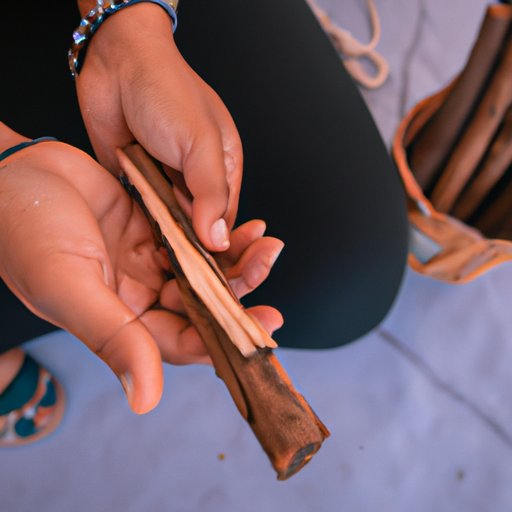Introduction
Cultural appropriation has become an increasingly controversial topic in recent years, with many people questioning whether certain products or practices are ethically produced or marketed. One such product is Palo Santo, a type of wood native to South America that has been used by indigenous people for centuries for its spiritual and healing properties. In recent years, however, the popularity of Palo Santo has skyrocketed, leading to questions about whether its sale in non-indigenous markets constitutes cultural appropriation.
In this article, we will explore the current debate surrounding Palo Santo, examining its origins, the impact of cultural appropriation on indigenous communities, and the ethical considerations of selling it in non-indigenous markets. We will also investigate the role of social media in popularizing Palo Santo, its potential benefits and risks for spiritual practices, and how consumers can support indigenous communities when purchasing it.
Examining the Origins of Palo Santo and How it Became Co-opted
Palo Santo, also known as Holy Wood, is a type of tree native to South America, particularly Peru, Ecuador, and Bolivia. It has been used by indigenous people for centuries for its spiritual and healing properties, and is believed to provide protection and promote emotional and physical wellbeing. The wood is burned as incense to purify spaces and is often used in traditional ceremonies and rituals.
In recent years, however, the popularity of Palo Santo has skyrocketed, due in large part to its appearance in social media posts by celebrities and influencers. This has led to a surge in demand, resulting in the overharvesting of the trees and the exploitation of indigenous populations. Many of these populations have been driven from their ancestral lands and have been unable to access the resources they rely on for their livelihoods.
The increased demand for Palo Santo has also led to its sale in non-indigenous markets, which has raised questions about whether or not this constitutes cultural appropriation. While some argue that the sale of Palo Santo in non-indigenous markets provides economic opportunities for indigenous communities, others maintain that it is unethical and exploitative.

Exploring the Impact of Cultural Appropriation on Indigenous Communities
Cultural appropriation has long been a source of contention between indigenous peoples and those who have colonized their lands. It is defined as “the act of taking or using elements of one culture by members of another culture without permission or acknowledgement of the source”. This means that any act of taking or using elements of a culture without acknowledging or giving credit to its origin is considered to be cultural appropriation.
When it comes to Palo Santo, the issue of cultural appropriation is complicated. On one hand, the sale of Palo Santo in non-indigenous markets has provided economic opportunities for indigenous communities. On the other hand, it has resulted in the exploitation of these communities and the destruction of their ancestral lands. Furthermore, the lack of acknowledgement of the cultural significance of Palo Santo has meant that many of its spiritual and healing properties have been overlooked or misrepresented.
Investigating the Ethics of Selling Palo Santo in Non-Indigenous Markets
The sale of Palo Santo in non-indigenous markets raises a number of ethical considerations. Firstly, there is the question of whether it is morally acceptable to sell a product that has been taken from its native region and is being sold for a much higher price than what the indigenous people receive for it. Secondly, there is the issue of whether it is appropriate to market a product that has deep cultural and spiritual significance without acknowledging or giving credit to its source.
Furthermore, there is the risk that the sale of Palo Santo in non-indigenous markets could lead to further exploitation of indigenous communities. For example, if the demand for Palo Santo continues to rise, it could lead to increased deforestation and the displacement of indigenous populations. Therefore, it is important to consider the potential risks and benefits of selling Palo Santo in non-indigenous markets before doing so.
Investigating the Role of Social Media in Popularizing Palo Santo
The popularity of Palo Santo has been largely driven by social media, with many celebrities and influencers posting pictures and videos of themselves using the product. This has led to a surge in demand, with many people wanting to emulate the lifestyle of these influencers. However, the influence of social media on Palo Santo’s popularity has had both positive and negative implications.
On the one hand, the increased popularity of Palo Santo has provided economic opportunities for indigenous communities. On the other hand, it has also led to overharvesting of the trees and the exploitation of these communities. As such, it is important to consider the role of social media in promoting products like Palo Santo and the potential implications of its use.

Assessing the Benefits and Risks of Using Palo Santo in Spiritual Practices
Palo Santo has long been used by indigenous people for its spiritual and healing properties, and is believed to provide protection and promote emotional and physical wellbeing. However, there are potential risks associated with its use, including the release of toxic chemicals when burned. Therefore, it is important to assess the potential benefits and risks of using Palo Santo in spiritual practices.
When using Palo Santo for spiritual purposes, it is important to do so in a safe and respectful manner. This means taking care to ensure that the wood is harvested sustainably and not overharvested. It also means avoiding burning the wood indoors or in enclosed spaces, as this can lead to the release of harmful toxins.

Considering How Consumers Can Support Indigenous Communities When Purchasing Palo Santo
When purchasing Palo Santo, it is important to ensure that you are supporting indigenous communities and not contributing to their exploitation. There are a number of ways to do this, including buying from companies that source their wood sustainably and pay fair wages to indigenous producers. Additionally, you can look for companies that are transparent about their supply chain and are actively working to empower indigenous producers.
You can also support organizations and initiatives that are working to protect indigenous peoples’ rights and promote sustainable production practices. By doing so, you can help to ensure that indigenous communities are able to access the resources they need to sustain their livelihoods and preserve their cultures.
Conclusion
The debate surrounding the cultural appropriation of Palo Santo is complex and multi-faceted. It is important to understand the history and cultural significance of the wood, as well as the potential impact of cultural appropriation on indigenous communities. It is also important to consider the ethical implications of selling Palo Santo in non-indigenous markets and the role of social media in popularizing the product. Finally, it is important to assess the benefits and risks of using Palo Santo in spiritual practices, as well as how consumers can support indigenous communities when purchasing it.
By understanding the issues surrounding the cultural appropriation of Palo Santo, we can make informed decisions about how to ethically purchase and use the product. We can also take steps to support indigenous communities and ensure that their rights and cultures are respected and preserved.
(Note: Is this article not meeting your expectations? Do you have knowledge or insights to share? Unlock new opportunities and expand your reach by joining our authors team. Click Registration to join us and share your expertise with our readers.)
